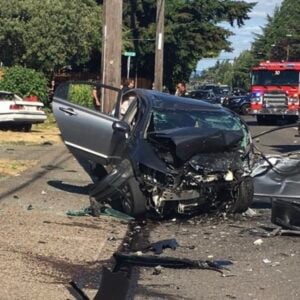It’s been over nine years now since we first shared the concept of “citizen initiated citations” here on BikePortland. At that time it was a little-known statute. Today, people are a bit more aware of it; but it’s still not a process that many people have gone through.
Unfortunately however, it’s still needed. As the number of people who operate vehicles illegally shows no signs of letting up and enforcement resources remain abysmal, it’s often the only option for justice. With an unusually high number of collisions and other incidents reported lately, we’ve decided to publish this article from Ray Thomas, the Portland-based lawyer and expert on bicycling issues who’s been at the forefront of citizen prosecution for nearly a decade.
(Note: Thomas uses “drivers” in his article, but his advice can be used by any road user regardless of how they get around.) — Jonathan Maus
Citizen Prosecution of Dangerous Drivers: How You Can Do It for Yourself
Some drivers drive so dangerously that some action must be taken to protect others. It is usually the case that a bad driver will offend again-and-again. When a driver uses a motor vehicle to harass or intimidate, or drives in a way that will be a danger to others, the victim is left with a tough choice: ignore it and move on, or follow-up and go through the process to pursue prosecution.
The first step is to use a mental checklist to ensure you can later identify the driver, the vehicle, and the license plate number.
If we let dangerous episodes slide then the person who is most vulnerable, like a solo tourist unfamiliar with the area, or someone with a medical condition, may well be the next victim. If there are no witnesses there is little likelihood a hit-and-run driver will ever be apprehended and punished. While it may be a hassle to pursue a dangerous driver, if you are able to obtain the license plate number, and identify the car and driver, then you have sufficient information to consider doing something more than just letting it go.
The first step is to use a mental checklist to ensure you can later identify the driver, the vehicle, and the license plate number. Repeating it over and over to yourself as a little sing-song, writing it in the dirt on the side of the road, typing it into your cellphone, or asking a passerby to let you use a pen and paper are all possibilities.
The bottom line is this: You need to obtain and retain the basic information about your suspect.
Law Enforcement Assistance; If Help Is Available Use It
When a driver commits a dangerous traffic offense that results in an injury or amounts to harassment it is always important to call the police and ask that an investigation be conducted and that the person be charged for a crime or traffic violation. When the police respond and pursue the case then the system is working as it should and justice is usually served.
However, many times the police decide they are too busy or the situation is not clear enough for them to get involved. This does not mean the driver is any less guilty of engaging in a dangerous driving practice, only that the police do not feel they can push the case.
In some instances it may be best just to let the situation resolve itself with inaction (for instance, if a police officer agrees to talk to the dangerous driver about their driving but declines to cite them for some reason).
However, sometimes the evidence of a dangerous violation of the law is clear and the driver will likely go on to harass others if they are allowed to escape punishment. In these situations it is possible to pursue the driver in court through Oregon’s Citizen Prosecution Statute (ORS 153.058). The Citizen Prosecution Statute allows regular citizens to initiate an action on a traffic ticket, to subpoena witnesses and present evidence at a trial in traffic court. If the driver is convicted, then the conviction is a moving violation just like what would be received if a police officer had initiated the case.
We Can Do It Ourselves
Oregon law allows a citizen to initiate traffic violation prosecutions in state court, and police help is ordered to be provided. I repeat, police assistance is required by the Oregon statute. But remember, the Oregon statute of limitations for violations is only six months; if the action is not filed within that time then the right to pursue a citizen violation is lost.
Advertisement
After the initial report is taken by the police or the traffic court clerk and the citizen signs the Oregon Uniform Citation and Complaint (a.k.a. the ticket), the completed paperwork is served on the offending driver by the police or court staff. The citation summons them to traffic court to face the charges in a non-jury trial in front of a traffic judge. At the trial the complaining citizen gives an informal presentation of the case, the judge hears evidence and testimony, and if convicted the bad driver receives a citation and fine for a moving violation – the same as if the ticket were issued by a police officer.
The process, known as an “Initiation of Violation Proceeding” is important for vulnerable roadway users – we usually get banged up the most in a collision with a car. Too many of these wrecks occur because some drivers fail to yield or share the road. These drivers are among the most dangerous drivers and it is important that their driving records reflect it. In addition some insurance adjusters fail to give adequate recognition to legal rights of non-motorized roadway users. Whether ignorant of the law or just hostile to the other side, these insurance adjusters see a collision case and instinctively favor their insured motorist.
Since only the most serious collisions involve law enforcement accident investigation, the person who is hurt after a clear cut violation of the traffic law by a motorist is often disappointed to learn that the driver (who was clearly admitting fault at the scene) is now claiming the other person was at fault. On the other hand if the official court record contains a citation and traffic court conviction of the driver, then the insurance adjuster will be hard pressed to ignore the true liability picture.
Follow The Recipe
The Oregon statute is detailed and task specific. It includes every step of the process. Few law enforcement personnel are likely to have direct experience with the process when it is initiated by a citizen; but most officers are very familiar with the Oregon Uniform Citation and Complaint form.
The law requires that the officer facilitate the process. If you dead-end with the officer who first responds then try the department non-emergency and/or traffic phone number. In rural areas, state police and sheriff officers share jurisdiction. The gravity of any injury and seriousness of the motorist’s traffic violation will greatly influence the officer’s response. Filing these cases over petty traffic standoffs is going to stress a tax-poor law
enforcement and court system struggling to contain Oregon’s dangerous traffic offenders. But in collisions resulting in injury in which the driver commits a clear violation of the traffic laws, a traffic violation conviction is an option that may be important later to clarify the legal cause of the accident and to make a legal record of the driver’s law violation.
How to Initiate a Citizen Initiated Violation Prosecution
First, learn the lingo and read ORS 153.058 so you can explain it to someone who has never heard of it and may not believe such an unheard of procedure exists until you actually show them the law (my firm’s website, www.stc-law.com, contains a how-to guide as well as forms and accounts from other citizens who have successfully used the process.
Once you have done the background research, here are your next steps:
1. Contact the officer who investigated your incident or facilitated exchange of traffic accident information, any other officer involved in your accident, the shift sergeant for that unit on that shift at the time of your accident, the commander for the unit, the executive officer’s office (Chief, Sheriff, whatever), the District Attorney’s office in your county, the City Attorney office in your city, the traffic department clerk in your local courthouse, or just about any staffer willing to speak with you about it in the courthouse or police station, and show them the statute and this article. If they don’t know about the process but are willing to ask someone about it, you will probably succeed in getting your case started if you are willing to allow the process to lumber up to speed.
Remember, you only have six months after the date of the incident to being these proceedings.
2. Once you get a law enforcement officer willing to start your violation proceeding then work through the process with them. They are supposed to create and send a summary of a complaint (which you may be required to swear to and sign), to the clerk’s office for issuance of a summons. The Oregon Uniform Traffic Citation and Complaint Form may be what most officers choose for issuance of the case. If an unhelpful person points out that ORS 153.058 says “A person other than an enforcement officer ‘may’ commence a violation proceeding…” so as to defeat your effort you must point out that the statute does not allow any discretion by the officer; the case must be commenced once the citizen’s complaint is lodged. You are the one with the discretion to do it or not, not the police or the court staff.
Further, the court has no discretion in issuing the summons as ORS 153.058 clearly states “the court ‘shall’ issue a summons to be delivered…”. There is some discretion provided to the court to amend or dismiss a complaint, but issuance of properly presented complaints should not be opposed.
3. Ask the officer who issued your case to help you find out about how to present your case. In traffic court you will be in the position usually occupied by the officer who wrote the ticket. Identification of the driver and presentation of evidence must be handled by you and your witnesses. The police or courts will help you issue subpoenas to other witnesses in advance of court. If you do not feel like you will be able to present your case then ask for help from the police officer or a friend.
Again, if you convince the judge at the trial that the defendant violated the law then the conviction that results will be like any other moving violation. If you need more help our office may be able to help, depending on the facts of your case.
Good luck! And if you’ve been through this process, please share your experiences and tips below.
— Ray Thomas – rthomas@stc-law.com
(Disclaimer: Swanson, Thomas, Coon & Newton law firm is a BikePortland advertiser and this post is part of an ongoing paid partnership.)






Thank You Ray!
just in time, since I’ve been wanting to do this process with the spate of recent high-profile collisions…
“In some instances it may be best just to let the situation resolve itself with inaction”
This was the case several months ago for me. I was on SE 30th at Hawthorne waiting when I noticed the driver behind me was angrily shouting at me to get out of his way; the light turned green and he dangerously sped around me, nearly hitting an oncoming vehicle and clipping my left leg. I followed him a few blocks away where he parked and non-chalantly walked back behind a house. A witness followed as well and stopped to see if I was okay, and after calling 911 an officer showed up and took down information. I ended up asking the officer to simply talk to the driver and that was it.
So….he wasn’t actually in a hurry? What a surprise.
Every driver that races somewhere should immediately leap out of their car and start sprinting to their destination. I rarely see this, though.
The driver clipped your leg with his car. A few more inches and he would have killed you. Why did you back off from filing a citation?
but it should still be done…
somebody runs a stop sign 1/2 a block from you? report it! the next time they might coast through and actually hit somebody…
we should enable bad drivers just because it will consume a police resource… the police would likely just be doing the same thing… we’re saving them the hassle by doing a lot of the work for them…
don’t wait for it to be something that tips over an imaginary threshold, report them now before it ever gets to that point…
drivers need to be concerned that at any time and any place they could be seen breaking any law by anybody and receive a ticket for it…
“we shouldN’T enable bad drivers”
You don’t need to have an officer come to the scene. You can start the process by going to the nearest precinct and filing a z-cite.
what’s a z-cite? I can only find references of it in Ray’s documentation…
A z-cite is a the citation issued for a traffic offense by police officers. Citizens can initiate a z-cite by going to local police precinct.
A c-cite if issued for traffic related felonies.
This can all be found in the Portland Manual of Policy and Procedures
https://www.portlandoregon.gov/police/article/32482
awesome, thanks for the link!
“…just about any staffer willing to speak with you…”
“Once you get a law enforcement officer willing to start your violation proceeding…”
“If you dead-end with the officer who first responds then try the department non-emergency and/or traffic phone number.”
For a law that purports to require the courts and/or police to assist in the process, this sounds like a lot of shopping around to find officers who are “willing” to provide their required assistance…?
Also, are there any rules about handling evidence, such as photos or video, so that it is admissible in court?
“Also, are there any rules about handling evidence, such as photos or video, so that it is admissible in court?”
I’d also like to know this… all my evidence will be video based…
my theory is that cameras don’t lie… I’m not going to hide the camera and it’ll be in public, so I don’t think wiretapping or privacy laws will come into play…
Once you’ve filed your case and before it goes to trial, sit in on a few traffic court sessions to watch how the officers present their cases. Generally, Multnomah County Traffic Court Downtown runs Monday thru Friday at 8:30 & 1:30. East County courthouse has traffic trials Mondays at 8:30 & 1:30 and Fridays at 8:30.
The officers use a cheat sheet to ensure they cover all the statutory requirements in their testimony. See if one will provide a copy.
props to Eilif Knutson who did a lot of the woodwork!